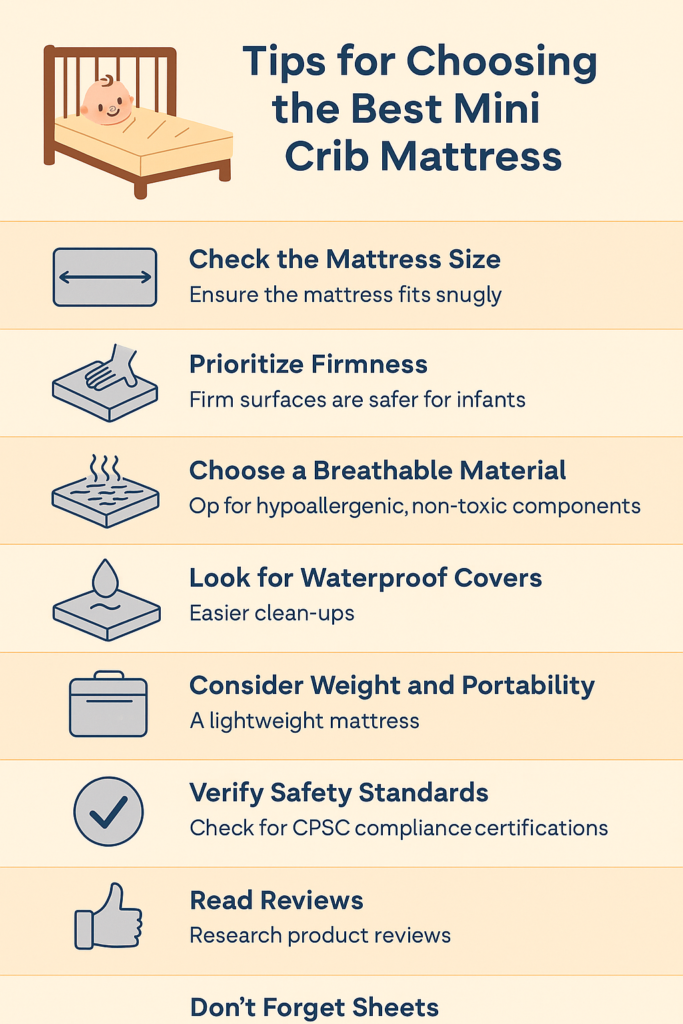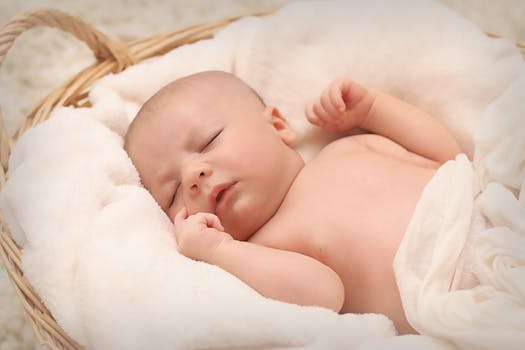When it comes to preparing your baby’s nursery, one of the most important decisions you’ll make is choosing the right mattress for your mini crib. Your baby will spend countless hours sleeping during their first year, so a safe and comfortable sleeping surface is essential. I can never forget the sleep regression period that caused me countless sleepless nights during my first born. With experience I got to know that having a right mini crib mattress can make those times so easy for me and my baby both.
While standard cribs and mattresses are common, mini cribs are a space-saving solution perfect for small nurseries, apartments, or co-sleeping arrangements. But how do you choose the best mini crib mattress?
Here are practical tips and essential features to look for when selecting a mini crib mattress for your little one.

1. Check the Mattress Size Compatibility
First things first—measure the mini crib. Mini cribs vary slightly in size, and not all mini crib mattresses are universally compatible. The standard size for a mini crib mattress is around 24 inches by 38 inches, but some cribs may be slightly narrower or shorter.
Tip: Look at your crib’s manufacturer recommendations and always choose a mattress that fits snugly. There should be no more than two fingers’ width of space between the mattress and the crib frame. Gaps pose a suffocation risk to infants.
2. Prioritize Firmness for Safety
For newborns and infants, a firm mattress is critical. Soft surfaces increase the risk of suffocation and Sudden Infant Death Syndrome (SIDS). The mattress should not sink under your baby’s weight.
To test firmness, press down on the center and edges of the mattress. It should bounce back quickly and not conform to the shape of your hand.
Avoid memory foam or overly plush materials for babies under one year old. Some dual-sided mattresses offer a firm side for infants and a softer side for toddlers—which can be a great investment.
3. Choose a Breathable and Hypoallergenic Material
Babies are sensitive to allergens, and they sweat more than adults while sleeping. Look for mattresses made with breathable, non-toxic, and hypoallergenic materials.
Consider features like:
- Organic cotton covers
- Natural or soy-based foam
- CertiPUR-US® certified foams
- GREENGUARD Gold Certification
These options reduce chemical exposure and improve air circulation, which helps regulate temperature and prevent overheating.

4. Look for Waterproof or Water-Resistant Covers
Let’s face it—babies are messy. Spit-up, diaper leaks, and drool are all part of the package. A waterproof cover will protect the mattress and make clean-up much easier.
Many mini crib mattresses come with a removable, washable cover or have an integrated waterproof layer. This keeps the mattress cleaner and helps prevent mold, bacteria, and odors.
If the mattress isn’t waterproof, consider investing in a separate waterproof mattress protector.
5. Consider Weight and Portability
Mini cribs are popular because they’re compact and easy to move. Choose a mattress that complements that mobility. A lightweight mattress makes changing sheets easier and moving the crib around more convenient.
If you travel often or plan to use a portable mini crib, look for a foldable or travel-friendly mini crib mattress that still offers firm support.
6. Verify Safety Standards and Certifications
Always check if the mattress meets CPSC (Consumer Product Safety Commission) standards. Certifications like:
- CertiPUR-US®
- GREENGUARD Gold
- OEKO-TEX®
…indicate that the mattress has been tested for harmful substances, emissions, and flammability. These certifications help you shop with peace of mind, knowing your baby is sleeping on a safe surface.
7. Read Reviews and Do Your Research
Before making a final decision, read reviews from other parents. Look for consistent feedback about durability, ease of cleaning, and fit. Product reviews can give you insight into potential issues you may not have considered.
You can also ask for recommendations in parenting forums or groups. First-hand experiences can point you toward trustworthy brands and help you avoid poor-quality products.
8. Don’t Forget About Sheets and Accessories
Once you pick a mattress, make sure to buy fitted sheets designed for mini cribs. Regular crib sheets won’t fit securely, which can create a safety hazard. Always use tightly fitted sheets to avoid loose fabric in the crib.
You may also want to add:
- A waterproof mattress pad
- A couple of spare sheets for easy swaps
- Breathable crib liners (only if recommended by your pediatrician)
Final Thoughts
Choosing the best mini crib mattress isn’t just about comfort—it’s about safety, health, and peace of mind. By selecting a well-fitting, firm, breathable, and certified mattress, you’ll give your baby the safest start possible.
Whether you’re setting up a nursery in a small space or need a portable sleeping solution, a mini crib and a high-quality mattress can be the perfect combo. With the right choice, you’ll both sleep better—literally.
Have a favorite mini crib mattress? Share your experience in the comments below! And don’t forget to check out our top picks for mini crib mattresses from Amazon .
